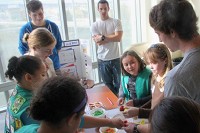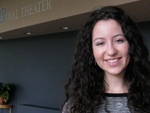Science Comes to Life for Area Girl Scouts at Kids Judge!

An interactive program placed 10-year-old Girl Scouts in the judge’s seat, evaluating University students’ presentations of neuroscience principles.
Timothy Cannon, Ph.D., professor of psychology, and students enrolled in his Behavioral Neuroscience class, along with the Neuroscience Society, recently hosted 70-plus Girls Scouts for this year’s installment of Kids Judge! The November event exposed the scouts to various projects presented by groups of three to five University students. The topics presented by the students ranged from color blindness to how the body relays messages of pain to the brain. The objective of the event was to teach children about science in a way they would find entertaining and easy to understand.
Kids Judge! was structured to allow the participating Girl Scouts to rotate in small groups through study rooms and laboratories in the Loyola Science Center to listen to the student presentations. However, the girls soon found out the presentations involved more than simply listening – they were actively engaged in presentations.
“The Pain Game,” presented by students Winna Mowenn ’14 of Morrisville, Alycia Bravyak ’14 of Forty Fort and Carolay Ceballos ’15 of New York, N.Y., taught the Girl Scouts how the spinal cord sends messages to the brain. The students illustrated the pathway using a paper map on the floor. Each scout then chose a hat to wear that designated them as an “A cell,” a “B cell” or “the brain.” Each “cell” then traveled the passageway to “the brain” and informed any other “cells” it encountered on the way that she was in pain.
“The passageway is extensive,” said Mowenn, who explained her group wanted to demonstrate “the idea that things are occurring before you say ‘ouch.’”
Marc Trignano ’15 of Morris Plains, N.J., and Alexandria Trefz ’15 of Aston gave a presentation on color and color blindness. After explaining the role cone cells play in seeing color, they provided colored pencils and venn diagrams designating circles for different hues for the girls to color. The diagrams represented subtractive color mixing, or the mixing of colors beginning with white and gradually darkening, as well as additive color mixing, which begins with black and gradually lightens.
When each student group was finished, the Girl Scouts judged the presentation as to whether it was enjoyable and informative. The Girl Scouts selected the following groups for first, second and third place:
First Place: “Optical Illusions” presented by: Joseph Breslin ’14 of Arlington, Va., Jordan Cuevas ’15 of Rye Brook, N.Y., Natalie Della Posta ’15 of Syracuse, N.Y., Nicholas Jacklett ’15 of Carmel, N.Y., and David Rennekamp ’15 of Stroudsburg.
Second Place: “Parts of the Brain” (or “Neuron in a Bag”) presented by Mark Cristiano ’13 of Cedar Grove, N.J., Jarek Ogorzalek ’14 of Bloomsbury, N.J., and Bernard Somers ’15 of Egg Harbor, N.J.
Third place (tie): “Synaptic Transmission” (or “Don’t Lose Ya Marbles”) presented by: James Moran ’15 of Toms River, N.J., Kayla Delgado ’15 of Boonton, N.J, and Jessica Lloyd ’13 of Moosic; and “Play-doh Ventricles” presented by: Nicole Riley ’15 of Swoyersville and Audrey Marinelli ’15 of Columbia, Conn.
Digital image:
University of Scranton students, standing from left, Jarek Ogorzalek ’14, Mark Cristiano ’13 and Bernard Somers ’15, use candy to illustrate the parts of the neuron to the edible delight of the Girl Scouts judging their presentation. The group of students placed second at the annual Kids Judge! event held in November at the University’s Loyola Science Center.
 Student Correspondent: Nicole Lopez-Isa '13, Saddle Brook, N.J., is a English major with a concentration in Latin American Studies at The University of Scranton.
Student Correspondent: Nicole Lopez-Isa '13, Saddle Brook, N.J., is a English major with a concentration in Latin American Studies at The University of Scranton.